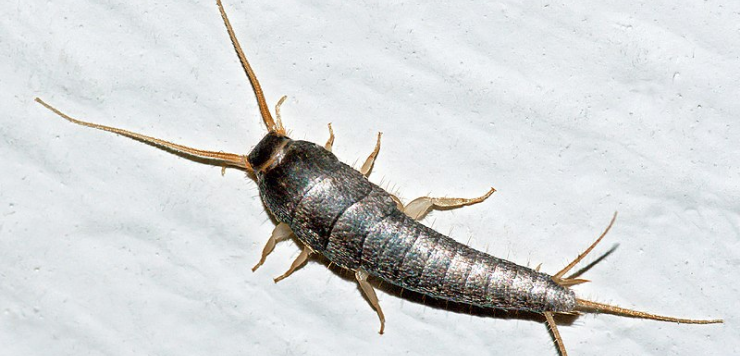
Silverfish - Lepisma saccharina
Key Features:
Silverfish are members of a primitive order of insects which moult as adults and have segmental appendages on their abdomen – both of these are features of extremely ancient insects.
The adult, when mature, is around 12 mm in length and generally grey or silvery/grey in colour.
The antennae are approximately two thirds the length of the body, and there are three processes extending from the posterior end of the abdomen and other short appendages on some of the hindmost abdominal segments.
The adult, when mature, is around 12 mm in length and generally grey or silvery/grey in colour.
The antennae are approximately two thirds the length of the body, and there are three processes extending from the posterior end of the abdomen and other short appendages on some of the hindmost abdominal segments.
Biology:
Each female silverfish lays approximately 100 eggs in her lifetime in a variety of locations. The eggs are oval in shape, approximately 1 mm in length, changing during their development from smooth white in appearance to brownish and wrinkled.
From the eggs develop the nymphal stage, which in the first few stages are white in colour, with the characteristic silvery / grey scale covering not being apparent until the fourth larval / nymphal stage.
Moulting continues throughout the life of the silverfish even when it is sexually mature, a feature which means that any lost appendages and limbs could be regenerated.
Humidity is important in the development of the silverfish with 90% relative humidity being the optimum for development of the nymphal stages. The optimum temperature for development is 22°C to 27°C at 75% to 97% relative humidity. In common with other insects, development times are influenced by temperature, relative humidity, moisture content, quantity and quality of food. The following figures are therefore only a guide.
From the eggs develop the nymphal stage, which in the first few stages are white in colour, with the characteristic silvery / grey scale covering not being apparent until the fourth larval / nymphal stage.
Moulting continues throughout the life of the silverfish even when it is sexually mature, a feature which means that any lost appendages and limbs could be regenerated.
Humidity is important in the development of the silverfish with 90% relative humidity being the optimum for development of the nymphal stages. The optimum temperature for development is 22°C to 27°C at 75% to 97% relative humidity. In common with other insects, development times are influenced by temperature, relative humidity, moisture content, quantity and quality of food. The following figures are therefore only a guide.
Egg 19-40 days
Nymph 90-120 days
Adult 1-3 years
Nymph 90-120 days
Adult 1-3 years
Distribution:
Cosmopolitan.
Significance:
Silverfish are nocturnal in habit and tend to hide during the day, therefore infestations may go unnoticed for considerable periods.
They are nuisance pests which can occasionally build up in numbers in areas of high humidity. Occasional damage to books etc has been attributed to silverfish but these examples are rare and only occur in areas where the books are likely to be damaged by damp in any case. Damage to textiles may occur. Wallpaper and wallpaper paste may be grazed upon, causing unsightly damage.
They are nuisance pests which can occasionally build up in numbers in areas of high humidity. Occasional damage to books etc has been attributed to silverfish but these examples are rare and only occur in areas where the books are likely to be damaged by damp in any case. Damage to textiles may occur. Wallpaper and wallpaper paste may be grazed upon, causing unsightly damage.
Control:
Treatment consists of removing any infested commodities and then the application of residual insecticide to cracks, crevices, floorboards, skirting boards etc.
It should be emphasised that these insects are harmless to man and do not bite.
